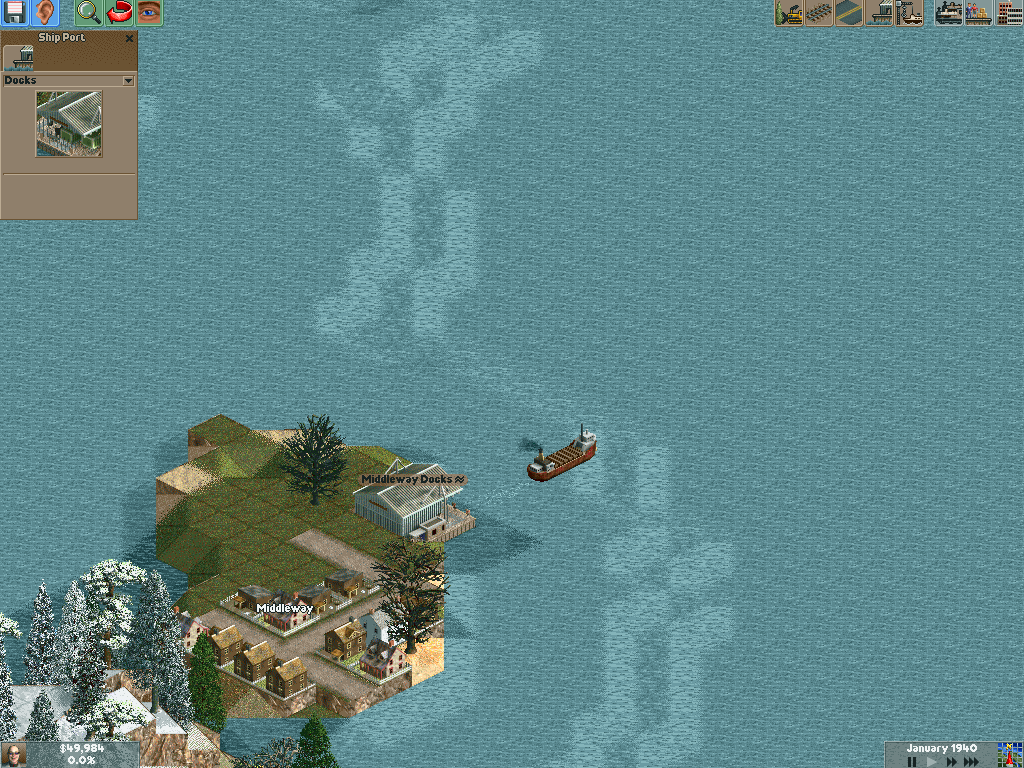Retro Replay Review
Gameplay
Chris Sawyer’s Locomotion builds on the deep mechanics of Transport Tycoon while leveraging the refined engine of RollerCoaster Tycoon 2. From the moment you select one of the 40 pre-made scenarios or craft your own custom map, you’re tasked with meeting clearly defined objectives—whether that means hauling a certain tonnage of coal, transporting passengers between key cities, or boosting your company’s overall reputation. Each scenario demands a tailored approach, and the early choice between trains, trams, buses, trucks, ships, or planes can set the tone for decades of play.
(HEY YOU!! We hope you enjoy! We try not to run ads. So basically, this is a very expensive hobby running this site. Please consider joining us for updates, forums, and more. Network w/ us to make some cash or friends while retro gaming, and you can win some free retro games for posting. Okay, carry on 👍)
As time marches forward—from the steam age of 1900 through the diesel and jet eras beyond 2000—you’ll unlock increasingly advanced vehicles. Deciding when to upgrade is critical: newer locomotives can offer greater speed and capacity but may also carry heftier price tags, which can eat into thin profit margins on shorter or less trafficked routes. Balancing income against expenses becomes a constant puzzle, ensuring that you never rest on your laurels once a line starts turning a profit.
Competition keeps the game world feeling alive and unpredictable. Multiple AI-controlled companies vie for the same lucrative contracts and town connections, requiring tactics that range from simply adding more vehicles to strategically placing blockades on rival tracks. These cutthroat encounters force you to stay one step ahead, whether by optimizing hub-and-spoke networks or by undercutting rivals on critical goods shipments.
For those who relish human competition, Locomotion offers a two-player mode over TCP/IP or LAN. Facing off against a friend injects dynamic, real-time tension into the management experience and tests your ability to adapt when someone else is racing to connect your most profitable cities.
Graphics
Locomotion’s visuals embrace the signature isometric pixel art that RollerCoaster Tycoon 2 popularized. Though it doesn’t boast 3D rendering, the game’s crisp sprites and bright color palette imbue each locomotive, factory, and town with a pleasing clarity. Tracks weave through hills and alongside rivers, while dynamic water animations signal bustling shipping lanes.
Vehicle sprites evolve over time as you unlock new models: the bulky steam engines of the early 1900s give way to aerodynamic diesels, each rendered with faithful detail. Towns grow and shrink based on your transportation network, and you’ll often catch sight of industries expanding in response to reliable goods delivery. The terrain editor also offers enough variation in hills, valleys, and coastlines to keep each custom world visually distinct.
The user interface mirrors the intuitive layout of Tycoon 2—toolbars line the screen edges, icons clearly denote track types and vehicles, and info panels pop up with relevant data on profit margins, cargo types, and town ratings. While some of the menus can feel dated by modern standards, their straightforward design reduces the learning curve once you’ve worked through the initial tutorial scenarios.
Story
Although Chris Sawyer’s Locomotion doesn’t feature a traditional narrative, its carefully curated scenarios weave together a sense of historical progression. Each map presents unique challenges tied to real-world regions: sprawling industrial North America, the rail-dense United Kingdom, and the winding valleys of the Alps. These settings conjure period-specific flavor without relying on cutscenes or scripted events.
Progression in each scenario crafts an emergent story of your own making. Will you turn a modest rural tram line into a cross-country freight empire? Can you breathe life into a struggling mountain town by reliably transporting its timber and livestock? Every objective you complete and every town you connect contributes to a living tableau of industrial growth.
For players who prefer sandbox play, Locomotion allows continued play even after experimental objectives are achieved. This open-ended structure fosters self-directed storytelling, as you watch towns boom or bust in response to your decisions. The narrative becomes less about a fixed sequence of events and more about the ebb and flow of a transport empire under your command.
Overall Experience
Chris Sawyer’s Locomotion stands as a robust transport simulation that honors its Transport Tycoon roots while modernizing key elements through the RollerCoaster Tycoon 2 engine. The depth of strategic planning—choosing routes, timing upgrades, and outmaneuvering rivals—delivers a satisfying blend of long-term ambition and moment-to-moment decision making.
Replayability is a core strength: 40 distinct scenarios, a detailed map editor, and competitive multiplayer mean you’ll return to the game again and again to test new strategies or simply enjoy the process of industrial expansion. Whether you’re guiding early steam engines or cutting-edge jets, the evolution of your network remains compelling throughout.
While the dated graphics and interface quirks may feel retro by today’s standards, they also evoke a charming nostalgia that many management-sim enthusiasts will appreciate. The learning curve can be steep for newcomers, but the comprehensive tutorials and gradually escalating challenges ease players into the complexity at a comfortable pace.
Ultimately, Locomotion delivers an engrossing sandbox of track-laying, timetable-tweaking, and profit-chasing that will delight anyone with a penchant for transport or tycoon-style games. Its combination of historical flavor, strategic depth, and creative freedom makes it a worthy addition to any simulation aficionado’s library.
 Retro Replay Retro Replay gaming reviews, news, emulation, geek stuff and more!
Retro Replay Retro Replay gaming reviews, news, emulation, geek stuff and more!









Reviews
There are no reviews yet.